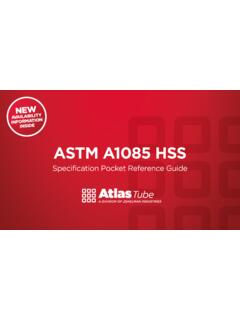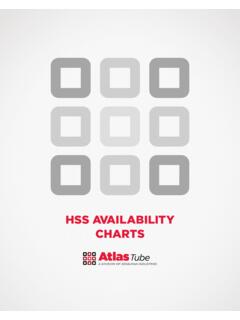Transcription of Hollow Structural Sections CSA G40.21 50W or Metric …
1 Hollow Structural SectionsCSA 50W or Metric 350W Class HWhat is CSA 50W / 350W Class H?In accordance with CSA , Hollow Sections welded or seamless round, square, rectangular or special-profile Structural tubing are available in two classes:Class CHollow Sections that are cold-formed from a section produced either by a seamless process or by an automatic electric-welding process producing a continuous H(i) Hollow Sections made by a seamless or furnace-butt welding (continuous welding) or automatic electric-welding process, and hot-formed to final shape; or(ii) Hollow Sections made by a seamless automatic electric-welding process producing a continuous weld, and cold-formed to final shape; subsequently stress-relieved by heating to a temperature of 450 C (850 F) or higher, followed by cooling in : General requirements for rolled or welded Structural quality use: General specification for plates, shapes, Hollow Sections , sheet, sheet piling, cold-formed channels and bars used in are the benefits of Class H?
2 Increased axial capacity in accordance with CSA S16-14 Savings in mass up to 20% Produced every 2 weeks in our Harrow PlantWhy do we produce material to a Class H Specification?In cold-formed HSS, we induce residual stresses in the finished product due to the rolling process. We begin with flat strip, form it into a round, weld it and subsequently shape it into to a square or rectangular residual stresses we induce are concentrated in the four corners and the weld line. Heat treating in a furnace will stress-relieve the product. The chemical properties of the material are not altered in any way; the physical properties might see a slight decline in the yield and tensile strength and an increase in the elongation, but all changes would be minimal.
3 As can be seen Table 1, the properties required by the specification for Class H are identical with Class is important to note that Class H is only available under the CSA specification. It is not available for ASTM A500 in the United Levels50W / 350 WYield Strength50,000 PSI (350 MPa) MinimumTensile Strength65,000 90,000 PSI (450 620 MPa)Elongation % in 2"22 MinimumChemistry Levels50W / MaximumGrain Refining MaximumAtlas Tube is the leading producer of HSS in East 122nd Street Chicago, IL 60633P F Clark Street Harrow, ON N0R 1G0P F do we produce Class H material?Material produced for CSA 50W / 350W Class H is run just as we would run CSA 50W / 350W Class C. This material is then moved to the furnace for heat treating.
4 The furnace cycle begins by heating the material from the ambient temperature of the warehouse at a rate of 125 F (52 C) per hour to the maximum temperature of 890 F (476 C). Once stable at 890 F (476 C), the temperature is held for 30 minutes. The load is then allowed to cool at a rate of 200 F (93 C) per hour from 890 F (476 C) back to ambient temperature. The material is removed from the furnace and moved to the shipping area for direct shipment to our customers. Tensile samples (heat-treated with the load) are pulled, and the results are recorded for each heat number, tube size and gauge. The material is checked for straightness and surface in mass of almost 20% are S16-14, Clause allows for n = when specifying CSA Class H material.
5 This will lead to higher axial capacities than those calculated for CSA Class C or ASTM A500 (see Table 2). This higher axial capacity could lead to using smaller Sections and subsequent mass savings over Class C and A500, as much as 20%. Even though there is a cost premium for Class H over Class C and A500, the potential for mass savings will translate to project cost East 122nd Street Chicago, IL 60633P F Clark Street Harrow, ON N0R 1G0P F 2 AXIAL CAPACITY8 X 8 X 1/4A500, GRADE CCSA CLASS CCSA CLASS HKL= 6m (19' 8')829 Kn ( 18 6 kips)920 Kn (207 kips)1130 Kn (25 4 kips)Class H: 36% more capacity than A50023% more capacity than Class C * Source: CISC Handbook of Steel Constructions, Tenth Edition (2014).
6 12 X 8 X 1/4A500, GRADE CCSA CLASS CCSA CLASS HKL= 8m (26' 3")675 Kn (152 kips)780 Kn ( 178 kips)951 Kn (214 kips)Class H: 41% more capacity than A50020% more capacity than Class C



